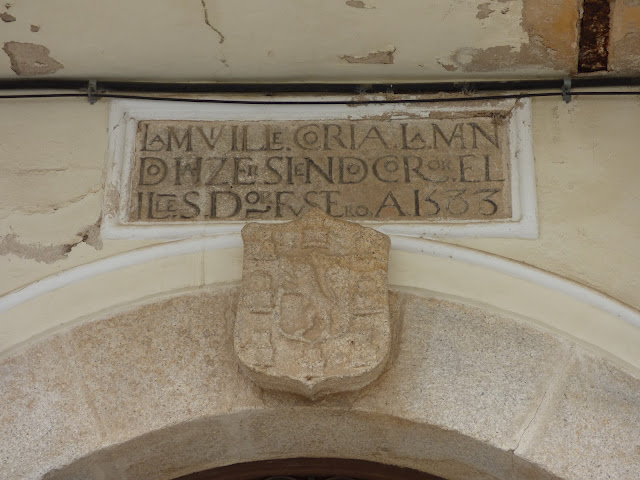A beautiful spring day for a trip to the Sierra de Gata in the north west of Extremadura. An area which borders Portugal with some spectacular mountain scenery and intriguing ancient villages.
The oak woods are just coming into bud, mountain streams, spring flowers and vast views.
Our first stop was Coria which is just to the south of the sierra, a bustling town with a long history due to its situation in fertile valley of the river Alagón.
Before the Roman conquest of Extremadura it was known as Caura, during Roman times it was an important trading post surrounded by a wall with 20 square towers and four gates, it is a magnificent example of Roman defence architecture from the 2nd though 4th centuries, preserving some original funerary steles.
The Visigoths established the Diocese of Coria, it was conquered by the Moors in the first quarter of the 8th century renamed Medina Caura, it remained on the border between Moorish and Christian lands during the 11th and 12th centuries until reconquest by the Christian king Alfonso VII in 1142. The Alba family were granted the lands which include Coria in 1472 and continued as an important influence until the 19th century, sadly the Alba palacio opposite the cathedral is in a very dilapidated condition, now home to pigeons and cats.
The catedral de Santa Maria de Asuncion was built on the site of the former mosque in a variety of styles during a period of 250 years beginning in the 15th century in Gothic-Renaissance style. The stone carving is a magnificent example of work by Manuel de Lara Churriguera and Diego Copín de Holanda
It is a pleasure to wander around the quiet streets of the walled town coming across other interesting sites such as the Royal prison and the Ecclesiastical prison, the convent of Madre Dios and castle tower which was built by the Dukes of Alba in the 15th century when they were given control of Coria by the Royal family.
There is an attractive restaurant and café with a garden and terrace in the old Bishop's palace which is now a hotel next to the Cathedral
From Coria it is another 40kms to our destination, the castle of Trevejo. The journey takes us through some lush scenery, stunning countryside with one big blot on the landscape, a town called Moraleja, really incredibly ugly with a 2km stretch of the most unfortunate examples of 60s and 70s cheaply built shops and houses, just ignore it and move on.
On a winding mountain road one glimpses the castle high up on the right before entering the village of Villamiel, it's just 2 kms further to the tiny hamlet of Trevejo now inhabited by just 24 people.
The houses are well kept and tiny gardens thrive with flowers and herbs. There were at least three Casa Rurales, I suppose they get busy in the summer when it might be cooler up here. We were happy to have this lovely little world to ourselves. The walk up to the castle is easy, there is a small church on the way with a separate bell tower and some interesting graves cut into the rock.
The castle is so gothically romantic, ancient lichened walls festooned with ivy, crumbling coats of arms, mysterious stone inscriptions, fabulous views and lethal drops, love it.
It was quite hot and strenuous clambering around the ruins so we made our way back to Villamiel for a drink and snack before moving on San Martin de Trevejo, another fascinating village in the Sierra de Gata which even has its own language, La Fala, a blend of Castellano, Portuguese and Gallego.
The streets are cobbled with a central gutter where there is a constant flow of water. Charming old houses with overhanging eves, a central plaza with arcades and a fountain, some cafés and restaurants, a super retro bar that looks like it's been there since the 50s complete with aspidistra.







































No comments:
Post a Comment
Follow the latest news from Finca al-manzil- What to do and see in Extremadura and Beyond.............